In the Gulf of Mexico (GoM), with complex salt geometry, it is not unusual to see coherent noise in subsalt imaging. Such noise is detrimental to subsalt exploration and appraisal as it often leads to incorrect interpretations. The coherent noise is related to converted waves, intra-salt multiples, residual free-surface multiples, seismic data acquisition noise, and etc.
Seismic processing from improved demultiple and noise attenuation will reduce post-migration coherent noise. Often we found that post-migration coherent noise attenuation is required to enhance the seismic data quality prior to structural and stratigraphic interpretation. Our approach is to decompose seismic images into dip image partitions (DIPs). The residual multiples can be suppressed by matching the multiple image with the seismic image in different DIP components. Also, when noise model doesn’t exist, if there is enough dip separation between seismic events and coherent noise, the coherent noise can be removed by applying a 3D filter to the DIPs.
Introduction
In the Gulf of Mexico, wide-azimuth and full-azimuth acquisition have been widely used to improve subsalt illumination and imaging. Due to the high-velocity contrast and complex geometries of salt bodies, free-surface multiples, interbed multiples, and converted waves are very strong and complicated in a lot of areas. In contrast to the different types of strong multiples, the reflectivity of subsalt events is very weak due to the high sediment-salt velocity contrast and complexity of the salt geometries. Therefore, multiple attenuation is imperative to attenuate the strong coherent noise to reduce the destruction to subsalt events. General surface multiple prediction is an advanced technology to predict complicated free-surface multiples. However, some residual multiples are still left in the data after multiple attenuation due to the model inefficiency and/or the preference of mild subtraction to not hurt signals. As to converted waves and interbed multiples, there is no known effective/efficient method to model them. In present days, multiple model migration becomes popular to be an additional product to help interpreters to identify signals from multiples. In addition, multiple model migration can be used as a multiple model to attenuate residual free-surface multiples in imaging domain. Interbed and converted waves are often observed in subsalt imaging, especially close to the base salt. In imaging domain, residual free-surface multiples, interbed multiples or converted waves can be attenuated if they present different characteristics in the dip image partitions (DIPs).
Let k = (kx, ky, kz) be an arbitrary wavenumber vector, p = (px, py, pz) is one of the dip direction unit vectors. Dip filters are of the form
F(k,p) = C*exp(- (1.0 - <k,p>^2 / (2*|k|^2*sigma^2)))
Where sigma controls the width of the filters; constant C is chosen so that the filters are a partition of unity, i.e., for each k, the sum of F(k,p) over all p’s is 1. Dip directions and wavenumber vectors are defined in a coordinate system with the x axis parallel to the primary axis, y parallel to the secondary axis, and z the depth, i.e., positive downwards. Figure 1 illustrates 36 spiral DIPs along azimuth and dip direction. The horizontal is azimuth, and the vertical is dip direction.
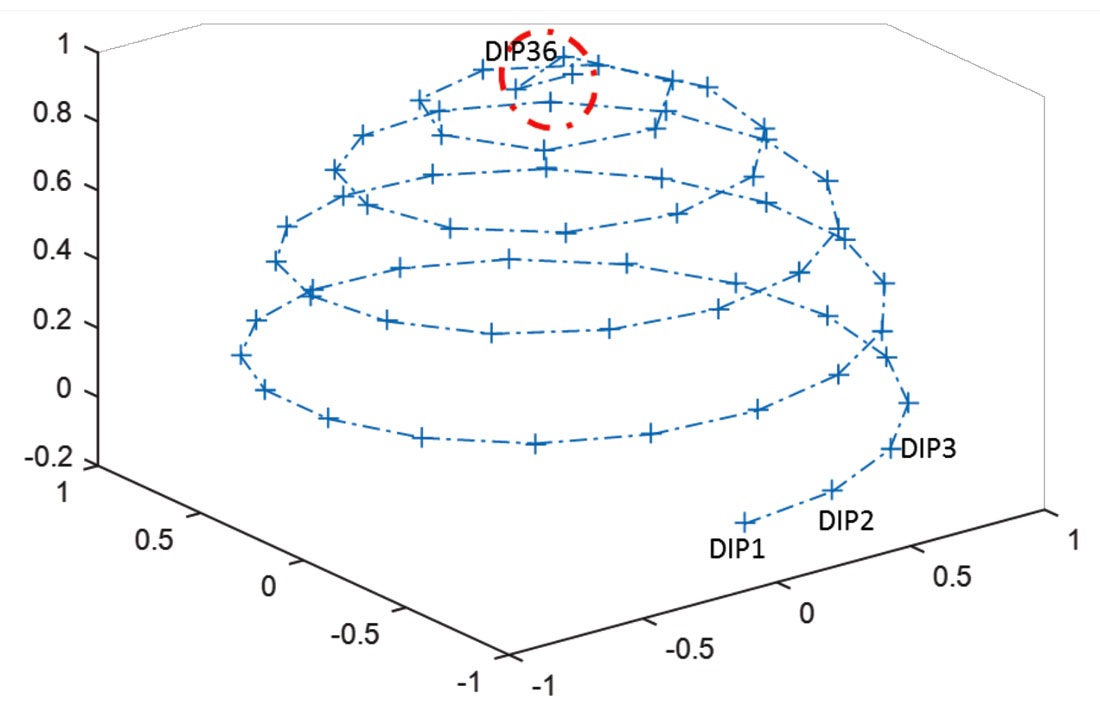
Residual surface multiple suppression by DIPs with multiple model migration
The residual multiple attenuation method involving multiple model migration presented here is: (1) decompose both the migrated seismic and migrated multiple model into DIPs; (2) Apply adaptive filter to the modeled DIPs to match seismic DIPs; (3) cross correlation of each DIP, one from the image and the other from the multiple model; (4) construct a weighting function from the cross correlation to suppress noise common to both the image and multiple model; (5) apply the weighting function to the image DIPs; and (6) weighted summation of the image DIPs to obtain residual multiple attenuated image.
Figure 2 illustrates the workflow to attenuate residual surface multiple in imaging domain with multiple model migration. Both the migrated image and multiple model are decomposed into DIPs to reduce the overlapping of signal and multiple events in image domain, therefore, easier to attenuate the multiples without hurting signals. Due to the large phase difference between the signal and multiple model, coherency is calculated on envelope attribute rather than the seismic itself. Salt mask is used in the flow to target subsalt multiples only.
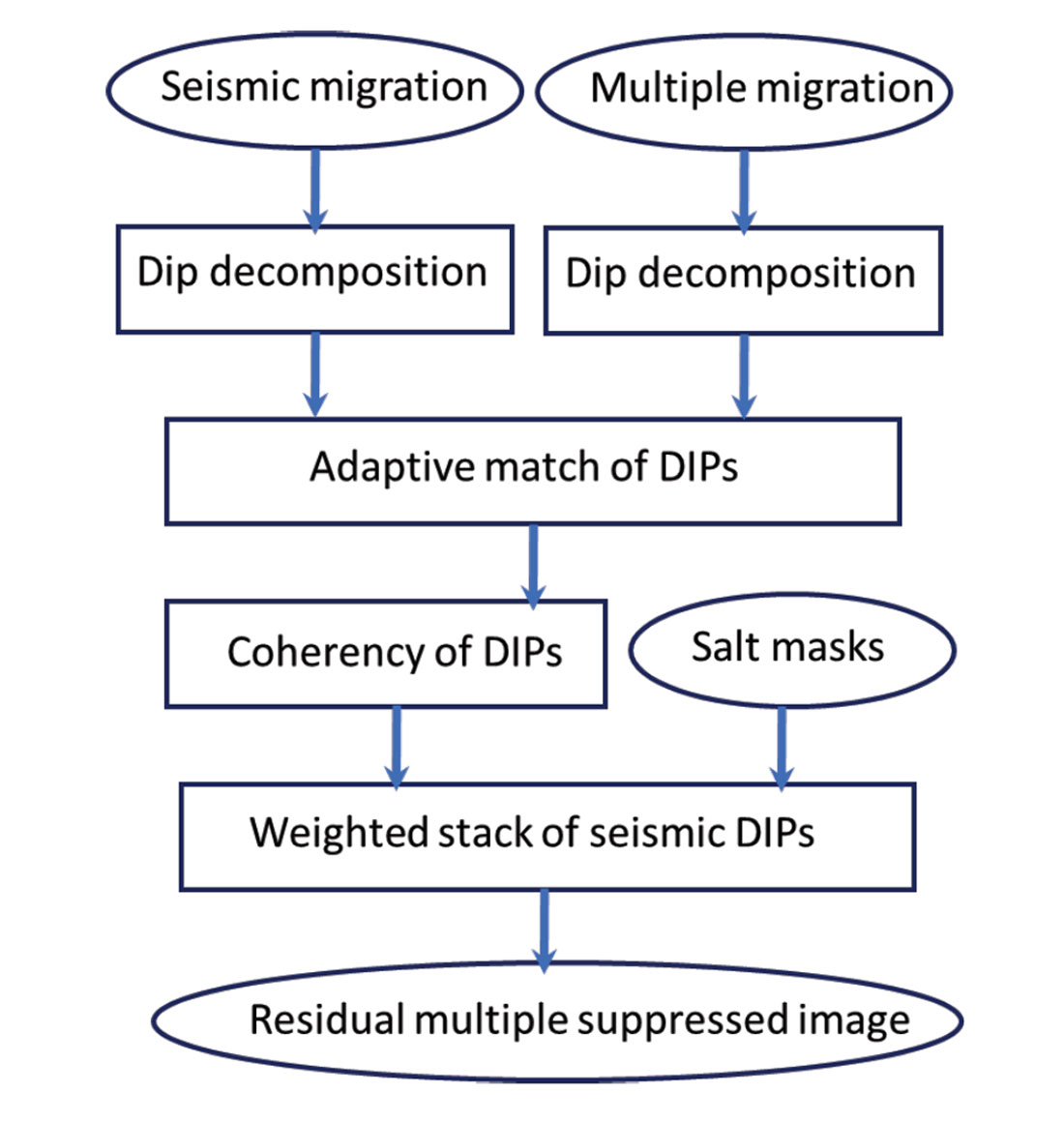
Figure 3 shows migrated image (3a), migrated multiple model (3b), one of the DIPs from seismic migration (3c) and multiple migration (3d) separately. In Figure 3a, in the red circled area, a cross-cut event is clearly observed to interfere with the subsalt events. It could be remnant base salt multiples, which also show up in the multiple migration (Figure 3b). By decomposing the migrated image, only base salt multiple is observed on both seismic migration and multiple migration in the shown DIP (Figure 3c, 3d); therefore, it is easier to suppress the multiple noise without attenuating signals.
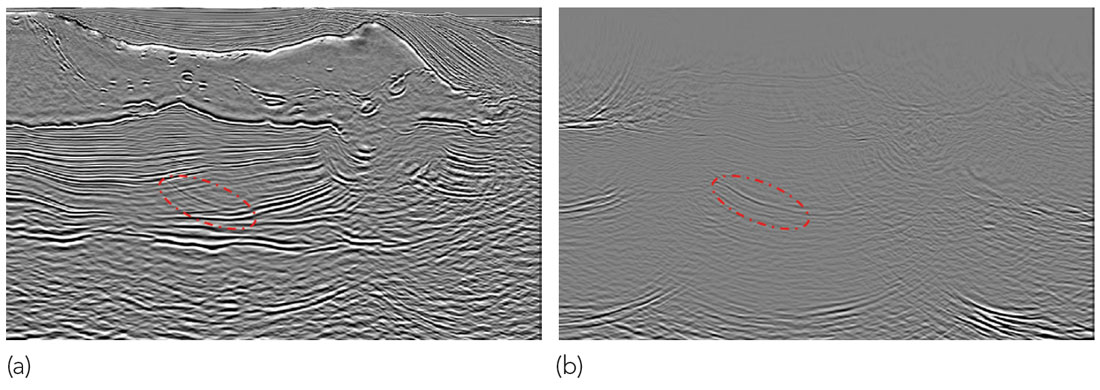
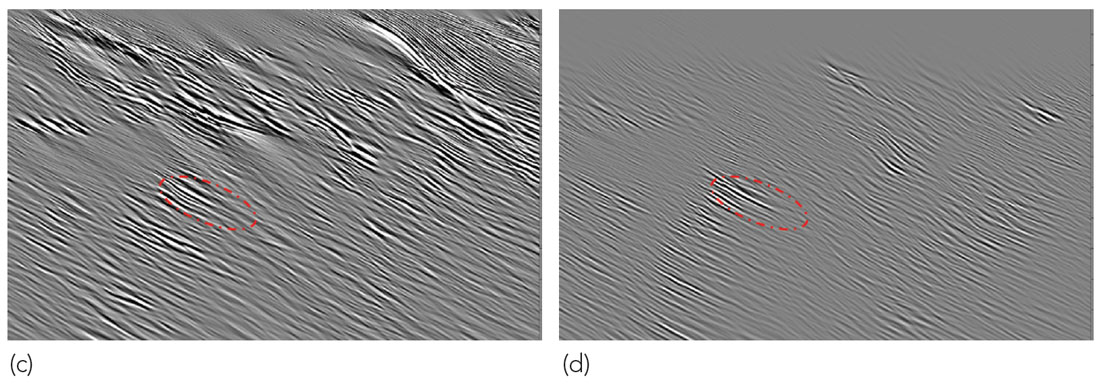
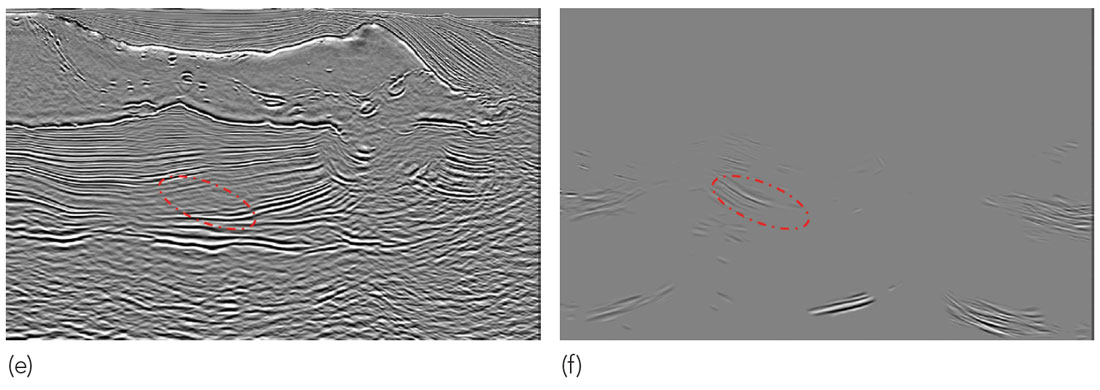
Due to the different amplitude, phase, and time, least-square adaptive filter is used to match seismic image vs. multiple migration.
Also, envelope cross-correlation is calculated to tolerate the big phase inconsistency. A spatially varied weight is calculated for each DIP based on the coherency between the seismic and multiple model migration, and then weighted summation (1-coherrency) is done to obtain the final residual multiple suppressed image (Figure 3e). Figure 3f shows the removed residual multiples from the migrated image. After residual multiple attenuation, the events in the circled area becomes much more continuous and easier to interpret. The multiples in serval other locations are also being very well attenuated (Figure 3e, 3f).
Coherent noise removal in imaging domain by selective stacking of DIPs
Very often, due to the complicated geology and salt geometry, even the most advanced multiple prediction algorithm is not able to model all the multiples. Therefore, migrated multiple model won’t help some residue multiple suppression in imaging domain. Also, we usually don’t model interbed multiples or converted waves. In this way, selective DIP stack can be used to remove residual free surface multiples, interbed multiples, or converted waves with the help of interpretation from geologist to identify coherent noise from signals.
The remnant coherent noise removal method presented here involves: (1) decompose the migrated seismic into DIPs; (2) analyze each individual DIP for the presence or absence of the targeted noise; (3) design a mask that spatially covers the targeted noise; (4) apply the mask to selected DIPs that contain the targeted noise; and (5) selectively stack a combination of original DIPs and masked DIPs to remove targeted coherent noise. Figure 4 illustrates the workflow to attenuate coherent noise by DIP decomposition. After decomposing the image into different DIPs, an interpreted mask is applied to the identified DIPs that contribute to the targeted noise. The targeted coherent noise is removed by subtracting the masked DIP stack from the migrated image.
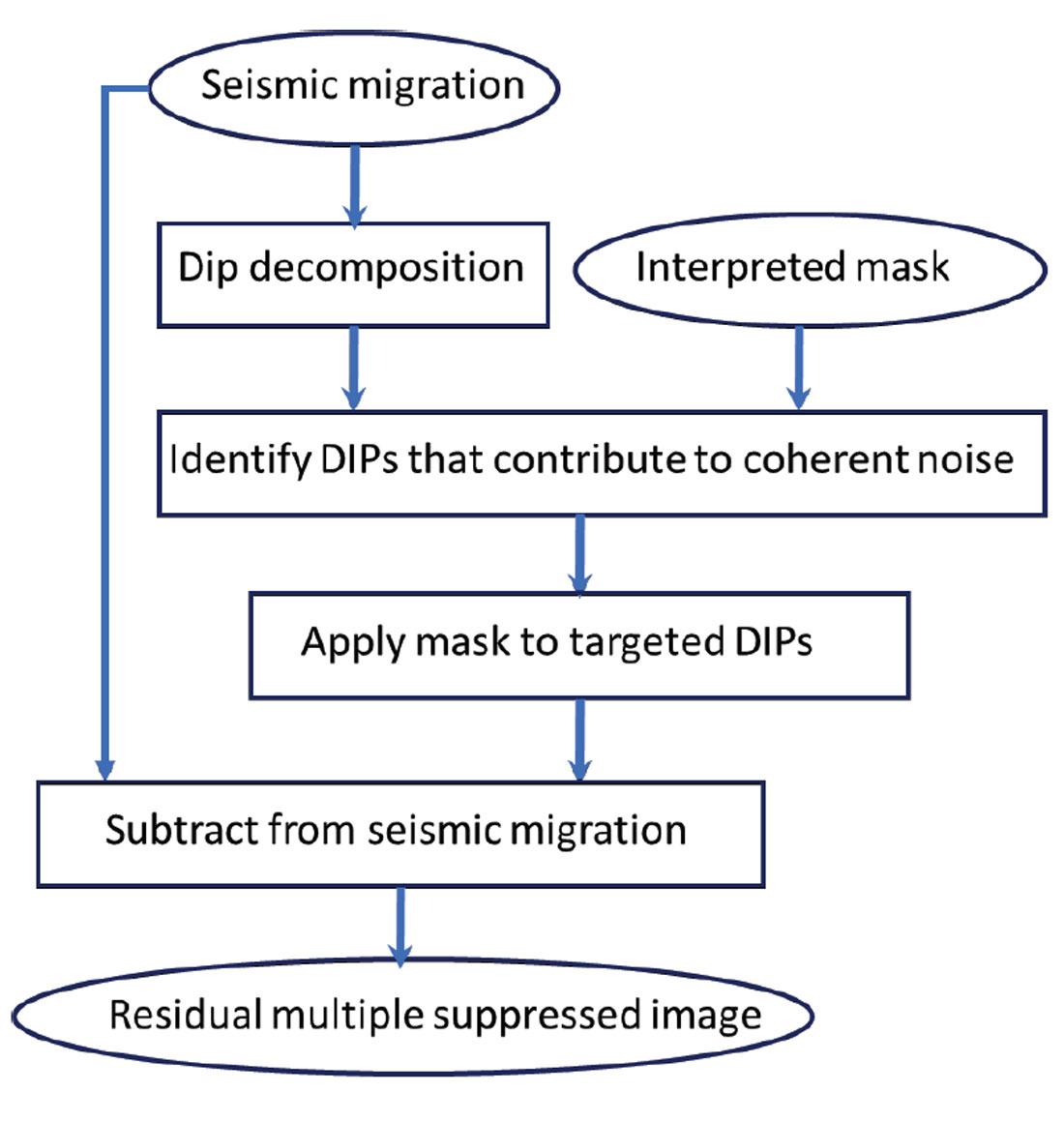
In Figure 5a, coherent noise is clearly observed below the base salt, generally parallel to the base salt. It could be converted waves from base salt due to strong velocity contrast or interbed multiples between top salt and base salt. A mask is defined using base salt horizon and a shifted base salt horizon (Figure 5b). Figure 5c shows one of the decomposed DIPs applied with the mask from Figure 5b, which mainly includes the subsalt coherent noise.
Figure 5d is the processed image after removing the coherent noise. After coherent noise removal, some subsalt events can be clearly traced to base salt, as is pointed out by the red arrows.
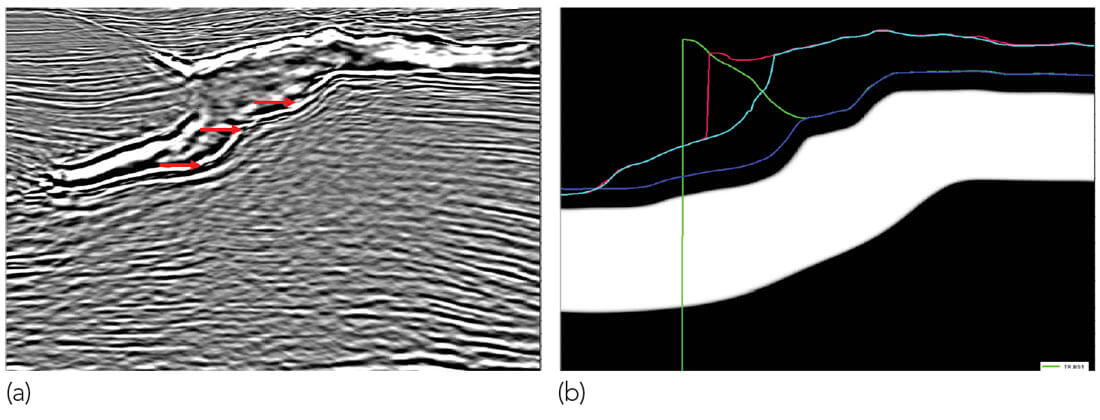
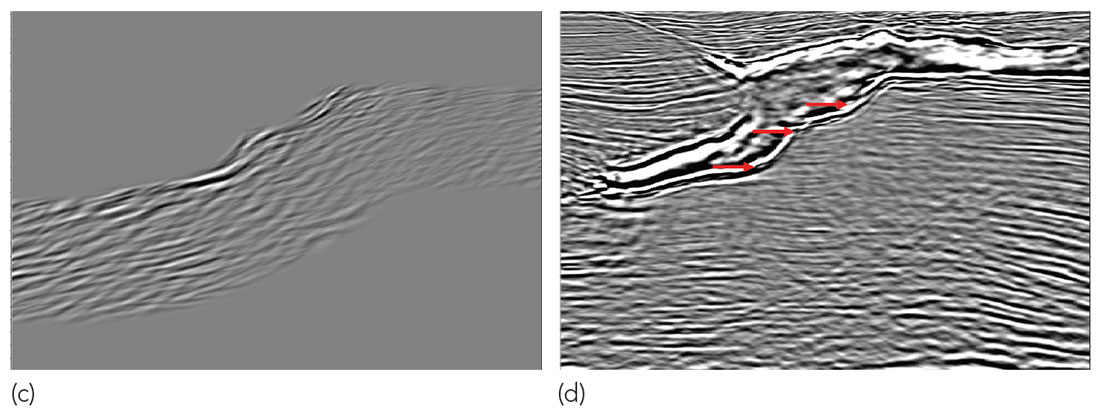
The residual surface multiples can also be removed with selective DIP stacking (Figure 6) if the multiple model is not available or if multiple model migration is not sufficient, although this method can only be applied locally with an interpreted mask. The base salt multiple is well removed by DIP decomposition and interpreted mask in this example.
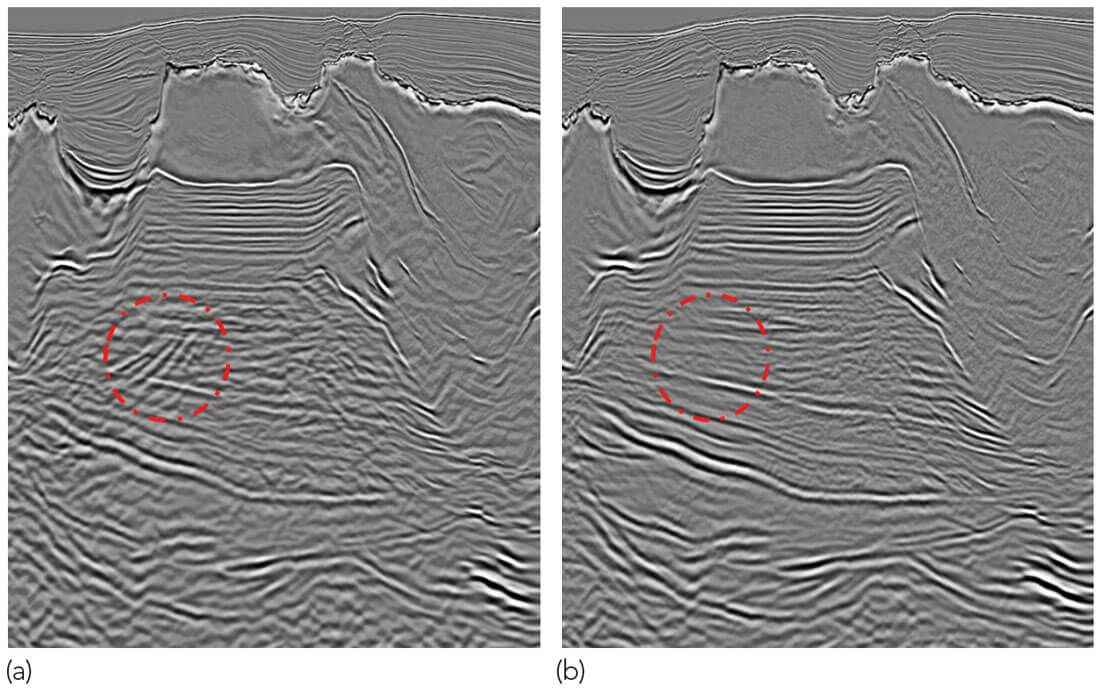
Conclusions
Coherent noise can be well attenuated by decomposing the image into dip image partitions (DIPs). Residual surface multiples could be attenuated by matching migrated image and migrated multiple model in different DIPs. Different types of coherent noises, including residual surface multiples, converted waves, and interbed multiples, can be attenuated by an interpreted mask and selective stack of the DIPs that contribute to the targeted noise. Several examples from the Gulf of Mexico clearly demonstrate the value of this method to the enhancement of subsalt imaging.

Acknowledgements
We thank WesternGeco Multiclient for the permission to use the data, we thank all the people who involved in processing the projects, and we also thank Seet Li Yang and Massimiliano Vassallo for reviewing this paper.










Join the Conversation
Interested in starting, or contributing to a conversation about an article or issue of the RECORDER? Join our CSEG LinkedIn Group.
Share This Article